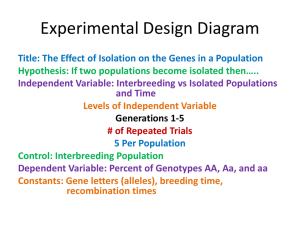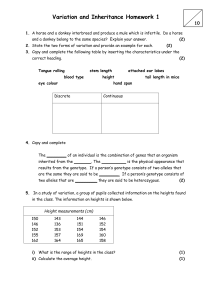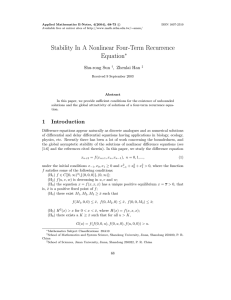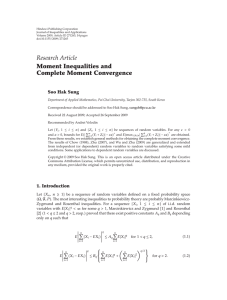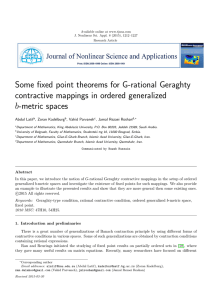GLOBAL ATTRACTIVITY IN A GENOTYPE SELECTION MODEL XIAOPING LI
advertisement
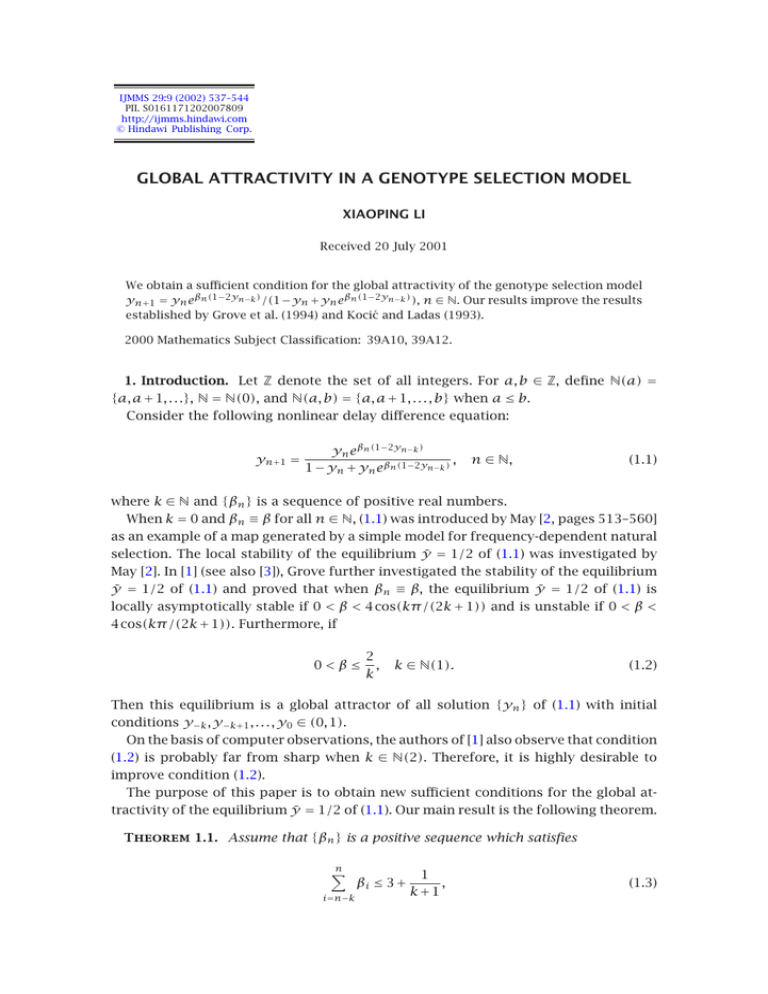
IJMMS 29:9 (2002) 537–544
PII. S0161171202007809
http://ijmms.hindawi.com
© Hindawi Publishing Corp.
GLOBAL ATTRACTIVITY IN A GENOTYPE SELECTION MODEL
XIAOPING LI
Received 20 July 2001
We obtain a sufficient condition for the global attractivity of the genotype selection model
yn+1 = yn eβn (1−2yn−k ) /(1−yn +yn eβn (1−2yn−k ) ), n ∈ N. Our results improve the results
established by Grove et al. (1994) and Kocić and Ladas (1993).
2000 Mathematics Subject Classification: 39A10, 39A12.
1. Introduction. Let Z denote the set of all integers. For a, b ∈ Z, define N(a) =
{a, a + 1, . . .}, N = N(0), and N(a, b) = {a, a + 1, . . . , b} when a ≤ b.
Consider the following nonlinear delay difference equation:
yn+1 =
yn eβn (1−2yn−k )
,
1 − yn + yn eβn (1−2yn−k )
n ∈ N,
(1.1)
where k ∈ N and {βn } is a sequence of positive real numbers.
When k = 0 and βn ≡ β for all n ∈ N, (1.1) was introduced by May [2, pages 513–560]
as an example of a map generated by a simple model for frequency-dependent natural
selection. The local stability of the equilibrium ȳ = 1/2 of (1.1) was investigated by
May [2]. In [1] (see also [3]), Grove further investigated the stability of the equilibrium
ȳ = 1/2 of (1.1) and proved that when βn ≡ β, the equilibrium ȳ = 1/2 of (1.1) is
locally asymptotically stable if 0 < β < 4 cos(kπ /(2k + 1)) and is unstable if 0 < β <
4 cos(kπ /(2k + 1)). Furthermore, if
0<β≤
2
,
k
k ∈ N(1).
(1.2)
Then this equilibrium is a global attractor of all solution {yn } of (1.1) with initial
conditions y−k , y−k+1 , . . . , y0 ∈ (0, 1).
On the basis of computer observations, the authors of [1] also observe that condition
(1.2) is probably far from sharp when k ∈ N(2). Therefore, it is highly desirable to
improve condition (1.2).
The purpose of this paper is to obtain new sufficient conditions for the global attractivity of the equilibrium ȳ = 1/2 of (1.1). Our main result is the following theorem.
Theorem 1.1. Assume that {βn } is a positive sequence which satisfies
n
i=n−k
βi ≤ 3 +
1
,
k+1
(1.3)
538
XIAOPING LI
for all large n, and
∞
βi = ∞.
(1.4)
i=0
Then every solution {yn } of (1.1) with initial conditions y−k , y−k+1 , . . . , y0 ∈ (0, 1) will
tend to ȳ = 1/2.
Corollary 1.2. Assume that βn ≡ β for all n ∈ N and
1
3
.
+
k + 1 (k + 1)2
β≤
(1.5)
Then every solution {yn } of (1.1) with initial conditions y−k , y−k+1 , . . . , y0 ∈ (0, 1) will
tend to ȳ = 1/2.
It is easy to see that when k ∈ N(2), (1.5) is an improvement on (1.2).
By a solution of (1.1), we mean a sequence {yn } that is defined for n ∈ N(−k) and
that satisfies (1.1) for n ∈ N. If a−k , a−k+1 , . . . , a0 are k + 1 given constants, then (1.1)
has a unique solution satisfying the initial conditions
xi = ai
for i ∈ N(−k, 0).
(1.6)
For the sake of convenience, throughout, we use the convention
j
rn ≡ 0,
whenever j ≤ i − 1.
(1.7)
n=i
2. Proof of Theorem 1.1. Let {yn } be a solution of (1.1) with initial conditions y−k ,
y−k+1 , . . . , y0 ∈ (0, 1). Then clearly, yn ∈ (0, 1) for all n ∈ N(−k). By introducing the
substitution
xn = ln
yn
,
1 − yn
n ∈ N(−k),
(2.1)
we obtain
∆xn + rn f xn−k = 0,
n ∈ N,
(2.2)
x−k , x−k+1 , . . . , x0 ∈ (−∞, ∞),
(2.3)
where
∆xn = xn+1 − xn ,
rn =
1
βn ,
2
f (x) = 2 −
4
.
ex + 1
(2.4)
It is easy to see that
f (0) = 0,
xf (x) > 0
x
4e
f (x) = 2
x
e +1
∀x ∈ R,
∀x ∈ R.
(2.5)
(2.6)
GLOBAL ATTRACTIVITY IN A GENOTYPE SELECTION MODEL
539
Thus, f is increasing, we also have
4ex
f (x) < √ 2 = 1
2 ex
for x ≠ 0,
(2.7)
which implies that
f (x) < |x| for x ≠ 0.
(2.8)
Define h as follows
h(x) = max f (x), −f (−x)
for x > 0.
(2.9)
We have from (2.5), (2.8), and the increasing property of f that h(x) is increasing
in [0, ∞), and
f (x) ≤ h |x| < |x| for x ≠ 0.
(2.10)
lim xn = 0.
(2.11)
We will now prove that
n→∞
There are two cases to consider.
Case 1. The sequence {xn } is eventually nonnegative or eventually nonpositive. We
assume that {xn } is eventually nonnegative, then there exists an integer n0 ∈ N(k)
such that xn−k ≥ 0 for all n ∈ N(n0 ). By (2.2), we have ∆xn ≤ 0 for all n ∈ N(n0 ) and
there exists a ≥ 0 such that
lim xn = a.
(2.12)
n→∞
If a > 0, by the increasing property of f , it follows that
∆xn ≤ −rn f (a)
∀n ∈ N n0 + k .
(2.13)
Summing (2.13) from n0 + k to n − 1 and using (1.4), we have
xn − xn0 +k ≤ −f (a)
n−1
ri → −∞ as n → ∞,
(2.14)
i=n0 +k
which contradicts (2.12). The case when {xn } is eventually nonpositive can be dealt
with similarly.
Case 2. The sequence {xn } is oscillatory. By (1.3) and (2.4), then there exists an
integer n∗ ∈ N(2k) such that
n
i=n−k
ri ≤ α =
3
1
+
,
2 2(k + 1)
xn∗ −1 xn∗ ≤ 0,
n ∈ N n∗ − 2k ,
xn∗ ≠ 0.
(2.15)
(2.16)
By virtue of the choice of n∗ , there exists a real number λ ∈ [0, 1) such that
xn∗ −1 + λ xn∗ − xn∗ −1 = 0.
(2.17)
540
XIAOPING LI
Let l be a positive constant such that
max
n∈N(n∗ −2k−1,n∗ −1)
xn ≤ l.
(2.18)
By (2.2), (2.10), (2.18), and the increasing property of h, we have
∆xn ≤ rn h(l),
n ∈ N n∗ − 1, n∗ + k − 1 .
(2.19)
Which, together with (2.17), implies that
xn−k = xn−k − xn∗ −1 − λ xn∗ − xn∗ −1 ∗ −2
n
∗
∆x
−
λ∆x
=
−
j
n −1 j=n−k
n∗ −2
≤ h(l)
rj + λrn∗ −1 ,
(2.20)
n ∈ N n∗ − 1, n∗ + k − 1 .
j=n−k
In view of (2.2), (2.10), and (2.20), we obtain
∗
n
−2
∆xn ≤ rn h(l)
rj + λrn∗ −1 ,
n ∈ N n∗ − 1, n∗ + k − 1 .
(2.21)
j=n−k
Now we show that
xn ≤ h(l) ∀n ∈ N n∗ , n∗ + k .
(2.22)
There are two possible cases to consider.
n∗ +k−1
Case 1. Suppose that d = i=n∗ ri + (1 −λ)rn∗ −1 ≤ 1. By (2.15), (2.17), and (2.21)
we have for n ∈ N(n∗ , n∗ + k)
xn = xn − xn∗ −1 − λ xn∗ − xn∗ −1 n−1
∗
∆x
+
(1
−
λ)∆x
=
i
n −1 i=n∗
≤
n∗
+k−1
ri h(l)
i=n∗
= h(l)
∗ −2
n
rj + λrn∗ −1 + (1 − λ)rn∗ −1 h(l)
j=n∗ −k−1
j=i−k
n∗
+k−1
i=n∗
ri
i
j=i−k
+ h(l)(1 − λ)rn∗ −1
∗ −2
n
rj −
i
rj − (1 − λ)rn∗ −1
j=n∗
∗ −1
n
j=n∗ −k−1
rj − (1 − λ)rn∗ −1
rj + λrn∗ −1
GLOBAL ATTRACTIVITY IN A GENOTYPE SELECTION MODEL
≤ h(l)αd −
n∗
+k−1
i=n∗
1
= h(l)αd −
2
i
ri
541
rj − (1 − λ)rn∗ −1 d
j=n∗
n∗
+k−1
i=n∗
1
1
= h(l)αd − d2 −
2
2
2
1
ri −
2
n∗
+k−1
i=n∗
n∗
+k−1
i=n∗
ri2 − (1 − λ)rn∗ −1 d
ri2 + (1 − λ)2 rn2∗ −1 .
(2.23)
Since
n∗
+k−1
i=n∗
ri2 + (1 − λ)2 rn2∗ −1
2
∗
n +k−1
1 d2
≥
ri + (1 − λ)rn∗ −1 =
.
k+1
k+1
i=n∗
(2.24)
We obtain
1
xn ≤ h(l) αd − 1 +
d2
2 2(k + 1)
1
1
+
≤ h(l) α −
2 2(k + 1)
(2.25)
= h(l).
n∗ +k−1
Case 2. Suppose that d = i=n∗ ri +(1−λ)rn∗ −1 > 1. In this case, there exists an
integer m ∈ N(n∗ , n∗ + k) such that
n∗
+k−1
ri ≤ 1,
i=m
n∗
+k−1
ri > 1.
(2.26)
i=m−1
Therefore, there is an η ∈ (0, 1] such that
n∗
+k−1
ri + (1 − η)rm−1 = 1.
i=m
By (2.15), (2.17), (2.19), and (2.21), we have for n ∈ N(n∗ , n∗ + k)
xn = xn − xn∗ −1 − λ∆xn∗ −1 n−1
=
∆xi + (1 − λ)∆xn∗ −1 i=n∗
=
n∗
+k−1
j=n∗
∆xj + (1 − λ)∆xn∗ −1 (2.27)
542
XIAOPING LI
∗
+k−1
m−2
n ∆xj + η∆xm−1 + (1 − η)∆xm−1 +
∆xj = (1 − λ)∆xn∗ −1 +
j=n∗
j=m
m−2
≤ h(l)(1 − λ)rn∗ −1 +
j=n∗
+ h(l)
n∗
+k−1
rj
j=m
∗ −2
n
rj + ηrm−1 + h(l)(1 − η)rm−1
rj + λrn∗ −1
j=m−1−k
∗ −2
n
ri + λrn∗ −1
i=j−k
m−1
= h(l)(1 − λ)rn∗ −1 +
rj − (1 − η)rm−1
j=n∗
m−1
+ h(l)(1 − η)rm−1
rj −
+ h(l)
j=m
j
rj
ri −
i=j−k
≤ h(l)α − (1 − η)rm−1 −
j
ri −
rj − (1 − λ)rn∗ −1
n∗
+k−1
m−1
ri − (1 − λ)rn∗ −1
i=n∗
i=m
j=m
j=n∗
j=m−1−k
n∗
+k−1
m−1
rj
j
ri
i=m
2
∗
n +k−1
n∗
+k−1
1
1
rj −
r 2
= h(l)α − (1 − η)rm−1 −
2
2 j=m j
j=m
∗ +k−1
2 1 n 1
2
r
= h(l) α − (1 − η)rm−1 − 1 − (1 − η)rm−1 −
2
2 j=m j
∗
n +k−1
1
1
2
2
2
rj + (1 − η) rm−1 .
= h(l)α − −
2 2
j=m
(2.28)
Since
n∗
+k−1
2
rj2 + (1 − η)2 rm−1
j=m
∗
2
n +k−1
1
1
. (2.29)
≥ ∗
rj + (1 − η)rm−1 ≥
n −m+k+1
k
+
1
j=m
We obtain
1
xn ≤ h(l) α − 1 −
= h(l).
2 2(k + 1)
(2.30)
Furthermore, we can prove that
xn ≤ h(l) ∀n ∈ N n∗ .
(2.31)
GLOBAL ATTRACTIVITY IN A GENOTYPE SELECTION MODEL
543
Assume, for the sake of contradiction, that (2.31) is not true. Then there exists m1 ∈
N(n∗ + k + 1) such that |xm1 | > h(l) and |xn | ≤ h(l) for n ∈ N(n∗ , m1 − 1). Set
m2 = max n ∈ N n∗ , m1 : xn−1 xn ≤ 0, xn ≠ 0 .
(2.32)
In case m1 ≤ m2 + k. From (2.10), we have
max
n∈N(m2 −2k−1,m2 −1)
xn ≤ h(l) < l.
(2.33)
By a similar method to the proof of (2.22), we obtain
xn ≤ h(l)
∀n ∈ N m2 , m2 + k
(2.34)
which contradicts the definition of m1 . In case m1 − 1 ≥ m2 + k, it follows from the
choice of m1 and m2 that
xn > 0
∀n ∈ N m2 , m1 .
or xn < 0
(2.35)
Assume that xn > 0 for all n ∈ N(m2 , m1 ). (In case xn < 0, the proof is similar.)
From (2.2) we have
∆xn ≤ 0 for n ∈ N m1 − 1, m1 + k
(2.36)
xm1 ≤ xm1 −1 ≤ h(l).
(2.37)
which implies that
This contradicts the definition of m1 . Thus (2.31) holds.
From the argument above, we can establish a sequence {ni } of positive integers
with n1 = n∗ , ni+1 − ni > 2k such that
xni −1 xni ≤ 0,
xni ≠ 0,
(2.38)
and a sequence {zi } with z1 = l, zi+1 = h(zi ) such that
max
n∈N(ni −2k−1,ni −1)
xn ≤ z i ,
xn ≤ zi+1
∀n ∈ N ni .
(2.39)
By (2.10), we obtain
lim zi = 0
i →∞
(2.40)
which, together with (2.39), implies that limn→∞ xn = 0. The proof is complete.
Acknowledgment. This work was supported by the Science Foundation of Hunan
Educational Committee of China.
544
XIAOPING LI
References
[1]
[2]
[3]
E. A. Grove, V. L. Kocić, G. Ladas, and R. Levins, Oscillation and stability in a simple genotype
selection model, Quart. Appl. Math. 52 (1994), no. 3, 499–508.
G. Iooss, R. H. G. Helleman, and R. Stora (eds.), Chaotic Behavior of Deterministic Systems,
North-Holland Publishing, Amsterdam, 1983.
V. L. Kocić and G. Ladas, Global Behavior of Nonlinear Difference Equations of Higher Order with Applications, Mathematics and Its Applications, vol. 256, Kluwer Academic
Publishers Group, Dordrecht, 1993.
Xiaoping Li: Department of Mathematics, Loudi Teacher’s College Loudi, Hunan
417000, China
E-mail address: ldlxpii@mail.ld.hn.cn


